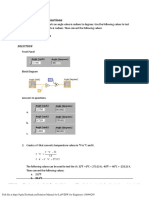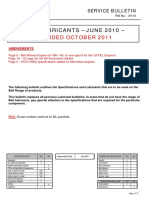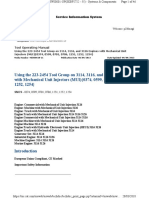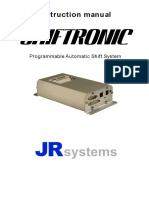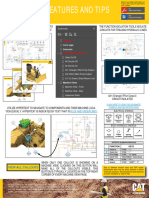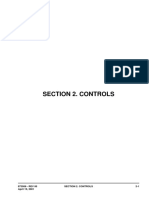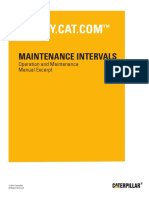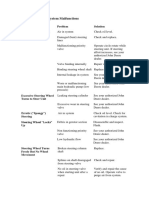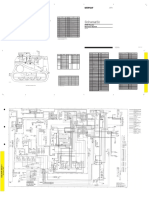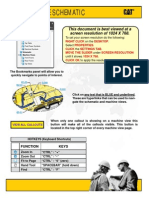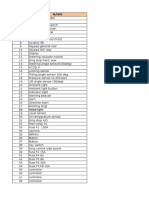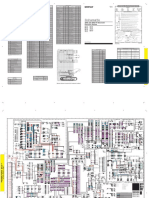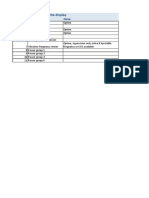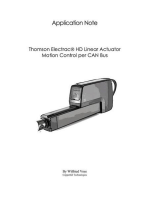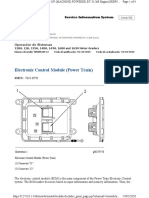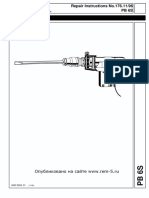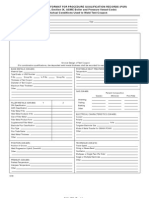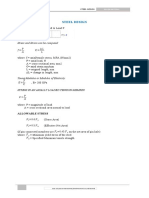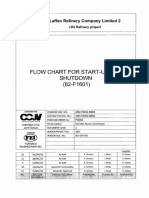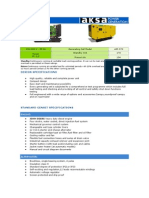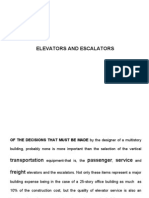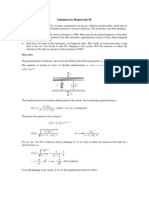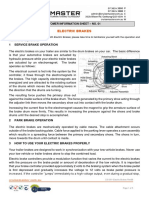Bell 1706C Plus System Checks
Bell 1706C Plus System Checks
Uploaded by
LeonCopyright:
Available Formats
Bell 1706C Plus System Checks
Bell 1706C Plus System Checks
Uploaded by
LeonOriginal Title
Copyright
Available Formats
Share this document
Did you find this document useful?
Is this content inappropriate?
Copyright:
Available Formats
Bell 1706C Plus System Checks
Bell 1706C Plus System Checks
Uploaded by
LeonCopyright:
Available Formats
SECTION 6.
SYSTEM CHECK
873506 - REV 00 SECTION 6. SYSTEM CHECKS 6-1
April 19, 2001
6-2 SECTION 6. SYSTEM CHECKS 873506 - REV 00
April 19, 2001
CHAPTER 30. TRANSMISSION
2. Transmission Diagnostics Output Checking
Input Checking The screen selector switch (M) must be pressed
while the APC50 is powered up for the digital display
The screen selector switch (M) must be pressed to indicate the input check (from the APC50 to the
three times (display at default) for the digital display transmission control valve solenoids). The display
to indicate the input check. The display indicates the indicates the active system outputs. The APC50 will
active system inputs (electrical signals from the joy- sequentially check all the system outputs.
stick control buttons and the park brake disconnect
signal to the APC50). A qualified serviceman can The left side of the digital display indicates the output
identify the sequence of segment illuminations in or- checked.
der to check the vehicle input wiring. Each segment The right side of the digital display indicates the out-
indicates a specific input wire. Two or more seg- put status.
ments may illuminate if two or more input wires are
activated simultaneously. The output status is indicated as follows:
Note: The vehicle can be driven while performing an G = Good
input check.
S = Short circuit to ground
Display examples are as follows:
O = Open, not connected or is shorting
to battery positive (+)
Note: When the output monitoring test is performed
the vehicle cannot be operated. The APC50 must be
powered down before the engine can be started.
Neutral Input wire 12 activated
(forward selection) Display examples are as follows:
(cab wire 6)
Input wire 19 activated Input wire 14 activated
(reverse selection) (upshift selection {+})
Output 1 is good
(cab wire 8) (cab wire 3)
Output 2 has a short
Input wire 15 activated Input wire 16 activated
(downshift selection {-}) (Not used)
circuit to ground
(cab wire 5)
Output 3 is not connected or
Input wire 17 activated Input wire 26 activated
(Not used)
has a short circuit to battery
(kickdown input)
positive terminals S002244
Input wire 25 activated
(Park brake disconnect
input)
S004410
873506 - REV 00 SECTION 6. SYSTEM CHECKS 6-3
April 19, 2001
Each output number corresponds to a specific out-
put wire. Refer to the table in Transmission Output Transmission Input Monitoring
Monitoring in this chapter When the mode button is pressed three times the
APC 50 will monitor all the transmission input wire
Refer to Section 8. Machine Schematics, Chapter
signals.
33. Electrical Schematics, 3. Transmission to
APC 50 Electrical Circuit . Note: This check will test the input signals between
the joystick / gear shift and the APC 50 transmission
Failure Codes control unit.
During normal vehicle operation the APC50 display The transmission input monitoring will be displayed
may automatically switch to the Failure codes dis- as follows:
play to indicate an active system failure. When the
Failure codes display is activated the T LED will flash
to attract operator attention to the active failure.
Display examples are as follows:
Neutral Input wire 12 activated
(forward selection)
(cab wire 6)
APC50 detects an active input signal
Input wire 19 activated Input wire 14 activated
on reverse or forward clutch. This is
an external failure and is NOT
(reverse selection) (upshift selection {+})
controlled by the APC50, this will be (cab wire 8) (cab wire 3)
the only failure code displayed.
Input wire 15 activated Input wire 26 activated
(downshift selection {-}) (kickdown input)
(cab wire 5)
S002243
APC50 detects a short in one or Note: The forward and reverse gear input wire dis-
more circuits. This is an external play is activated while the machine is in gear
failure and is NOT controlled by (holding signal).
the APC50, this will be the only Note: The upshift and downshift selection input will
failure code displayed. only be displayed while the up shift or down shift but-
S004414 ton is pressed (momentary signal).
Note: The kick down input will only be displayed
while the kick down button is pressed (momentary
signal).
6-4 SECTION 6. SYSTEM CHECKS 873506 - REV 00
April 19, 2001
3. The transmission output monitoring will be dis-
Transmission Output Monitoring played as the following examples:
Note: This check will test the output signals between
the APC 50 transmission control unit and the trans-
mission control valve electrical solenoids.
For transmission output monitoring the following
must be done:
Output 1 is good
T F
Output 2 has a short
circuit to ground
S002390
1. Press and hold the mode button (1) down.
Output 3 is not connected or
ON has a short circuit to battery
positive terminals S002244
4. Each output display number corresponds to a
specific output wire.
The output numbers to output wire is as follows:
Normal Out-
Output
Condi- put Switched Function
Number
S002381 tion Wire
1 Good 6 Forward solenoid (park
2. Turn the ignition switch to the ON position (while
brake released)
holding the mode button {M}).
2 Good 7 Reverse solenoid (park
brake released)
3 Good 4 Number 1 solenoid
4 Good 5 Number 2 solenoid
5 Good 9 Number 3 solenoid
6 Good 13 Aux.(BLS - load arm sus-
pension switch) output -
3rd /4th gear activated
7 Open 8 Warning indicator (Turbine
speed too high)
8 Good 3 Power available to starter
solenoid or input error
873506 - REV 00 SECTION 6. SYSTEM CHECKS 6-5
April 19, 2001
Note: When the park brake is applied Output 1 and 2 T Light Emitting Diode (LED)
will show Open. When the park brake is fully re-
leased (park brake indicator not illuminated) Output When the T LED is illuminated, the APC 50 does not
1 and 2 will show Good. detect any vehicle speed (the machine is stationery).
Note: When checking output wires refer to Section Note: If the T LED remains illuminated when the ma-
8. Machine Schematics, Chapter 33. Electrical chine is moving there is a fault with the speed
Schematics, 3. APC 50 Electrical Circuit. sensor.
When an output error short circuit is detected at The T LED will illuminate while the machine is oper-
power up the APC 50 will display an EO code (Error ating to indicate that the downshift inhibitor is faulty.
Output) or EI code (Error Input). If the T LED illuminates while operating the following
If the error is detected while the machine is in opera- must be done:
tion EO or EI will flash on the APC 50 display and the
T LED will flash. 1. Stop the machine using the service brakes
If an output short circuit occurs with one of the gears 2. Shut down the engine
while the machine is operating the transmission will
still allow gears to be selected, only the affected gear 3. Contact your nearest BELL Customer Support
will not be selected. Representative.
If an input short circuit occurs with one of the sole-
WARNING
noids the transmission will receive the forward and
reverse gear selection at the same time. The APC When the T LED illuminates while the machine is
50 will display EI and force the transmission to select moving the machine must be stopped immedi-
neutral. ately as serious damage to the machine and/or
serious injury to personnel may result from abu-
sive gear shifting.
The T LED will indicate that the speed sensor has
failed and the downshift inhibitor is not operating and
must be repaired immediately.
6-6 SECTION 6. SYSTEM CHECKS 873506 - REV 00
April 19, 2001
CHAPTER 31. HYDRAULIC SYSTEM CHECKS
1. Hydraulic System Checks
Hydraulic System Components
The following illustration details the positioning of the machine hydraulic valve components.
11 12 1 2 3 4 5
10 9 8 7 6
S005259
1. Pilot pressure accumulators (1 off) 7. BLS valve (optional)
2. Brake charge valve 8. Park brake calliper
3. Priority valve 9. Steering valve
4. Return manifold block 10. Main pump
5. BLS accumulators (optional) 11. Transmission charge pump
6. Control valve 12. Brake accumulators (5 off)
873506 - REV 00 SECTION 6. SYSTEM CHECKS 6-7
April 19, 2001
Test Point Positioning
The following illustration details the positioning of the machine test points.
E A
C B D
S005260
G F
A. Control valve (pump pressure to loader system) test point, located on the rear of control valve
(inside the front chassis)
B. Brake charge pressure test point
C. Steering pressure (priority valve) test point
D. Hydraulic return pressure test point
E. Transmission charge pressure test point
F. BLS Pressure test point (optional)
G. LS pressure to pump test point
Checking the Hydraulic Pressures
CAUTION
If the hydraulic pressures are incorrect serious machine damage may result.
Note: The machine pressures are factory set and are only to be checked when diagnosing hydraulic system
faults or when a hydraulic component is replaced.
1. Clean the relevant pressure check point and the area around the point.
2. Remove the pressure check point cap.
3. Fit a suitably calibrated pressure gauge to the check point.
6-8 SECTION 6. SYSTEM CHECKS 873506 - REV 00
April 19, 2001
The following table details the machines hydraulic test points and set pressures.
Hydraulic System Pressure Table
Pressure Description Test point Setting Pressure Check Procedure
Pump (11) standby 2 300 kPa (334 psi) Engine idling- all functions
neutral
F002637
Pump (11) maximum operating 25 000 kPa (3 656 psi) Engine idling- Bucket held
against roll-back stop. All
pre-set relief cartridges cor-
rect
A
F002637
Control valve (6) - Load arm up 25 000 kPa (3 656 psi) Engine idling- Load arm held
maximum operating up against stop-all other pres-
sures set
F002637
Control valve (6) - Load arm 16 000 kPa (2 321 psi) Engine idling- Load arm held
down maximum operating down against stop-all other
pressures set
A
F002637
Control valve (6) - Bucket roll 15 000 kPa (2 176 psi) Engine 1500 RPM- bucket
forward maximum operating rolled forward against stops.
All other pressures correct
A
F002637
873506 - REV 00 SECTION 6. SYSTEM CHECKS 6-9
April 19, 2001
Hydraulic System Pressure Table
Pressure Description Test point Setting Pressure Check Procedure
Control valve (6) - Bucket roll 25 000 kPa (3 626 psi) Engine idling- bucket held
backwards maximum operat- against roll-back stop. All
ing other pressures correct
A
F002637
Priority valve (10) steering LS 17 000 kPa (2 466 psi) Engine idling. Steering held
relief against articulation stop
C
F002638
Priority valve (10) standby 800 kPa (116 psi) Engine idling. all functions
neutral
C
F002638
Brake valve (2) charge 11 000 kPa to 13 500 Engine idling- apply brakes to
kPa (1 595 psi to 1 958 induce charge cycle
psi)
F002639
Low brake valve (2) warning 9 000 kPa (1 305 psi) Engine off, ignition switched
on- watch dash light
F002639
6-10 SECTION 6. SYSTEM CHECKS 873506 - REV 00
April 19, 2001
Hydraulic System Pressure Table
Pressure Description Test point Setting Pressure Check Procedure
Park brake calliper (8)hold-off 9 000 kPa (1 305 psi) Engine off, brakes charged
and gradually applied until
pads just contact disc
F002639
Brake accumulator (13) 4 000 kPa (580 psi) Engine off, brakes gradually
pre-charge applied. Last reading on
gauge before pressure drops
to zero is lowest of accumula-
B tor's pre-charge pressures
F002639
Pilot pressure accumulator (11) Any control valve (6) pilot line 3 500 kPa (508 psi) Engine off, joystick gradually
charge applied. Last reading on
gauge before pressure drops
to zero is accumulator's
pre-charge pressure
Pilot pressure accumulator (11) Any control valve (6) pilot line 1 500 kPa (218 psi) Engine off, joystick gradually
pre-charge applied. Last reading on
gauge before pressure drops
to zero is accumulator's
pre-charge pressure
Hydraulic tank nominal charge 40 kPa (5.8 psi) 'Relieve tank pressure. Per-
form transmission warm-up
D test to allow pressurization of
tank. Do not use hydraulic
functions.
F002640
System maximum (4) operating Maximum 200 kPa (29 Bucket fully raised, engine off.
return psi) Lower bucket swiftly to
D ground.
F002640
873506 - REV 00 SECTION 6. SYSTEM CHECKS 6-11
April 19, 2001
Hydraulic System Pressure Table
Pressure Description Test point Setting Pressure Check Procedure
Transmission charge pump 1 600 kPa to 1 900 kPa Engine idling, transmission
(11) (232 psi to 276 psi) warm and in neutral
F002641
6-12 SECTION 6. SYSTEM CHECKS 873506 - REV 00
April 19, 2001
You might also like
- Caterpillar 3406 Engine Service Manual S N 70v1Document7 pagesCaterpillar 3406 Engine Service Manual S N 70v1المهندسوليدالطويل65% (17)
- SM ADT B18E To B30E PIN 1 1 RevADocument358 pagesSM ADT B18E To B30E PIN 1 1 RevALayaan ChitikiNo ratings yet
- Bell B25D & B30D Engine Operation InfoDocument16 pagesBell B25D & B30D Engine Operation InfoOthnielNo ratings yet
- Solution Manual For LabVIEW For Engineers 136094295 PDFDocument12 pagesSolution Manual For LabVIEW For Engineers 136094295 PDFAyesha TahirNo ratings yet
- D250E II/D300E II Articulated Truck Operator StationDocument1 pageD250E II/D300E II Articulated Truck Operator StationJulio EspinozaNo ratings yet
- LubricantsDocument17 pagesLubricantsChristopherNo ratings yet
- Sis - Cat.com Sisweb Sisweb Techdoc Techdoc Print Page PDFDocument46 pagesSis - Cat.com Sisweb Sisweb Techdoc Techdoc Print Page PDFMiguel GutierrezNo ratings yet
- Deep Sea Electronics PLC: DSEL400 & DSEL401 Operator ManualDocument83 pagesDeep Sea Electronics PLC: DSEL400 & DSEL401 Operator ManualMostafa ShannaNo ratings yet
- V A35d A40d Lowp 211 4170 0304Document8 pagesV A35d A40d Lowp 211 4170 0304ahmad fikriNo ratings yet
- Acoustical Testing Services Test Method Selection ListDocument8 pagesAcoustical Testing Services Test Method Selection ListMatnSambuNo ratings yet
- Bell B30D Engine Parts ManualDocument82 pagesBell B30D Engine Parts ManualOthnielNo ratings yet
- D-Series ADT (B35D-B50D) Mark 7.4 StageII-English (Broch15790614) WebDocument24 pagesD-Series ADT (B35D-B50D) Mark 7.4 StageII-English (Broch15790614) WebAlejandro Quiñonez100% (2)
- Bell ADT D-Series General InfoDocument32 pagesBell ADT D-Series General InfoOthniel100% (1)
- Interactive Schematic: This Document Is Best Viewed at A Screen Resolution of 1024 X 768Document16 pagesInteractive Schematic: This Document Is Best Viewed at A Screen Resolution of 1024 X 768Plstina RamsNo ratings yet
- Service Maunal 2306D 2806D MK 5 SMDocument431 pagesService Maunal 2306D 2806D MK 5 SMerickbothaNo ratings yet
- 216 ElectricalDocument2 pages216 ElectricalJunior Edder Aguilar Apolaya100% (1)
- Instruction Manual: Programmable Automatic Shift SystemDocument25 pagesInstruction Manual: Programmable Automatic Shift SystemmarcinNo ratings yet
- BELL B35D & B40D Operation and Test ManualDocument453 pagesBELL B35D & B40D Operation and Test ManualpalasgedoNo ratings yet
- Renr9780renr9780-03 NGSDocument15 pagesRenr9780renr9780-03 NGSFabrizio JesúsNo ratings yet
- KSS 80 ZV-2 - Elektri̇kDocument5 pagesKSS 80 ZV-2 - Elektri̇kBerat DeğirmenciNo ratings yet
- 2.steering and Dumping Valve IlustrationDocument2 pages2.steering and Dumping Valve IlustrationTLK ChannelNo ratings yet
- 05 ElectricDocument79 pages05 ElectriccristianNo ratings yet
- 424 Eletrical CircutDocument4 pages424 Eletrical CircutveereshNo ratings yet
- ADT Service ManualDocument152 pagesADT Service ManualZakhele MpofuNo ratings yet
- Schematics E50Document9 pagesSchematics E50pronomix100% (3)
- Installation IQAN-XT2 Installation IQAN-XT2 Installation IQAN-XT2 Installation IQAN-XT2 Installation IQAN-XT2Document2 pagesInstallation IQAN-XT2 Installation IQAN-XT2 Installation IQAN-XT2 Installation IQAN-XT2 Installation IQAN-XT2jhonatan_silveira_8No ratings yet
- Dokumen - Tips 872091 b35d b40d Operation and Test Manual1Document453 pagesDokumen - Tips 872091 b35d b40d Operation and Test Manual1MichaelNo ratings yet
- Small Adt MkII Elec SchematicsDocument19 pagesSmall Adt MkII Elec SchematicsSMM ENTREPRISENo ratings yet
- Fault Code 144: Coolant Temperature Sensor CircuitDocument3 pagesFault Code 144: Coolant Temperature Sensor Circuitjorgeroa111No ratings yet
- Bull Dozer D9 J3D00307 - Schematic Electric and HydraulicDocument61 pagesBull Dozer D9 J3D00307 - Schematic Electric and Hydraulicridha yunitaNo ratings yet
- B50D MK6.1 Feb+'10Document823 pagesB50D MK6.1 Feb+'10Ravinder SinghNo ratings yet
- Anulador Del NeutralizadorDocument3 pagesAnulador Del NeutralizadormartinaguilarespinoNo ratings yet
- D7R Track Type Tractor Electrical System (Differential Steer)Document2 pagesD7R Track Type Tractor Electrical System (Differential Steer)JorgeNo ratings yet
- 345B L Excavator Electrical System (SENR1937-01)Document2 pages345B L Excavator Electrical System (SENR1937-01)sughieantoNo ratings yet
- Da30 Da40 PDFDocument20 pagesDa30 Da40 PDFRiri MukhtarNo ratings yet
- 1997 - Tundra 2 ManualDocument183 pages1997 - Tundra 2 Manualjames graupmannNo ratings yet
- Diagrama Electrico D9L 14y CaterpillarDocument2 pagesDiagrama Electrico D9L 14y CaterpillarPedro Ruiz100% (1)
- Bell 1706C Plus ControlsDocument34 pagesBell 1706C Plus ControlsLeon100% (1)
- HitachiDocument166 pagesHitachipiaspark100% (4)
- D5M Track-Type Tractor Maintenance ManualDocument50 pagesD5M Track-Type Tractor Maintenance ManualLubetech1993No ratings yet
- Pressure Build Up - SteeringDocument3 pagesPressure Build Up - Steeringwidanto0apriawanNo ratings yet
- SE4310Document2 pagesSE4310Brando ImanuelNo ratings yet
- General Information: Systems OperationDocument9 pagesGeneral Information: Systems OperationAhmed RezkNo ratings yet
- D155ax-6 Sebm038800 PDFDocument15 pagesD155ax-6 Sebm038800 PDFM. Arpani Yoga PranataNo ratings yet
- DTC DeutzDocument19 pagesDTC Deutz7777jpbpb5No ratings yet
- V-Ecu Input OutputDocument3 pagesV-Ecu Input OutputNikolay CenovNo ratings yet
- JD 770CH Diagnose Steering System MalfunctionsDocument3 pagesJD 770CH Diagnose Steering System Malfunctionsenriquevazquez27No ratings yet
- Cat 966GDocument2 pagesCat 966GCarlos Arturo AcevedoNo ratings yet
- D10N Serie 2YD PDFDocument2 pagesD10N Serie 2YD PDFpedro cNo ratings yet
- 725 Elec SCH UENR1766Document12 pages725 Elec SCH UENR1766nikbeam100% (1)
- NEEG2746-13 Coupling Master Crimp Diameter and Length Reference ChartDocument1 pageNEEG2746-13 Coupling Master Crimp Diameter and Length Reference ChartMORTEMNo ratings yet
- 735 ADT Parking Release Manual - 022828Document3 pages735 ADT Parking Release Manual - 022828Sohail AnaanNo ratings yet
- 7346285Document11 pages7346285onrabiNo ratings yet
- 385C and 385C FS Excavator Electrical SystemDocument4 pages385C and 385C FS Excavator Electrical SystemNova kurniawan 34No ratings yet
- CA - AlarmsAndWarnings Códigos DSSDocument9 pagesCA - AlarmsAndWarnings Códigos DSSCinthya Collaguazo100% (1)
- 773d PDFDocument2 pages773d PDFjesusNo ratings yet
- Thomson Electrac HD Linear Actuator Motion Control per CAN BusFrom EverandThomson Electrac HD Linear Actuator Motion Control per CAN BusNo ratings yet
- Rental & Leasing of Heavy Construction Equipment Revenues World Summary: Market Values & Financials by CountryFrom EverandRental & Leasing of Heavy Construction Equipment Revenues World Summary: Market Values & Financials by CountryNo ratings yet
- Ecm 140HDocument4 pagesEcm 140HmdqNo ratings yet
- Electronic Control Module (Power Train) : Operación de SistemasDocument4 pagesElectronic Control Module (Power Train) : Operación de Sistemasgalvis1020100% (3)
- Keyence AS - 64893 - CV-X - IO - SG - 369GB - GB - WW - 1084-1Document24 pagesKeyence AS - 64893 - CV-X - IO - SG - 369GB - GB - WW - 1084-1Gabriel Martinez MessnerNo ratings yet
- Meiden Vt240 CircuitsDocument1 pageMeiden Vt240 CircuitsPur WantoNo ratings yet
- Cat Plasma SF-2100SDocument6 pagesCat Plasma SF-2100STech CIMNo ratings yet
- Control: Programmable Controller For Use in Vehicles and Off-Highway MachineryDocument7 pagesControl: Programmable Controller For Use in Vehicles and Off-Highway MachineryLeonNo ratings yet
- Bell 1706C Plus ControlsDocument34 pagesBell 1706C Plus ControlsLeon100% (1)
- Atlas Copco PB 6SDocument10 pagesAtlas Copco PB 6SLeonNo ratings yet
- PB 6SDocument10 pagesPB 6SLeonNo ratings yet
- Aptiv Connection Systems Catalog: Our Journey Innovation CareersDocument3 pagesAptiv Connection Systems Catalog: Our Journey Innovation CareersLeonNo ratings yet
- 14033Document2 pages14033Priyanathan ThayalanNo ratings yet
- Shapes BrochureDocument12 pagesShapes BrochureKhor Tze MingNo ratings yet
- Steel Design: Stress and Strain can be computed f= P A Є= ∆ L LDocument23 pagesSteel Design: Stress and Strain can be computed f= P A Є= ∆ L Lnathan fajardo100% (2)
- Api 610 Datasheet PDF FreeDocument7 pagesApi 610 Datasheet PDF FreeRisyda PutriNo ratings yet
- Howden - FFP Free Floating Piston Lowres PDFDocument4 pagesHowden - FFP Free Floating Piston Lowres PDFdigecaNo ratings yet
- Muhammad Zikril HafizDocument8 pagesMuhammad Zikril HafizPrabhuNo ratings yet
- Pinter ManocombDocument40 pagesPinter ManocombCpNo ratings yet
- 256-F0052-8953 - X2 Flow Chart F1601Document13 pages256-F0052-8953 - X2 Flow Chart F1601rajavinugmailcomNo ratings yet
- 60 BPM CSD For 250 ML Arvind AquaDocument17 pages60 BPM CSD For 250 ML Arvind AquaOMKAR JADHAVNo ratings yet
- Development of EPA Tier 4 Certified Diesel Engines For 2-3t Forklift TrucksDocument6 pagesDevelopment of EPA Tier 4 Certified Diesel Engines For 2-3t Forklift TrucksTien NguyenNo ratings yet
- Application of Groundwater FlowDocument25 pagesApplication of Groundwater Flowfuji100% (1)
- Ajd 170 PDFDocument4 pagesAjd 170 PDFmhmmd14No ratings yet
- Thermodynamics Important-1Document2 pagesThermodynamics Important-1dubeykrishna41105No ratings yet
- BS 534 Stell Pipes For Water& SewerageDocument27 pagesBS 534 Stell Pipes For Water& Seweragenawadh athuman0% (1)
- Elevators and EscalatorsDocument38 pagesElevators and Escalatorsshrikant100% (11)
- Optimizing Gas Supply For Industrial Lasers: OEM ScopeDocument8 pagesOptimizing Gas Supply For Industrial Lasers: OEM ScopeHaryanto GunawanNo ratings yet
- ME 503-N Manufacturing TechnologyDocument4 pagesME 503-N Manufacturing Technologyhrana287No ratings yet
- Department of Manufacturing Engineering Laporan Makmal / Laboratory Report BDX 10703 Material Engineering Technology Lab Front Cover Full ReportDocument8 pagesDepartment of Manufacturing Engineering Laporan Makmal / Laboratory Report BDX 10703 Material Engineering Technology Lab Front Cover Full ReportDas SagaNo ratings yet
- Wartsila o e Ls x82Document2 pagesWartsila o e Ls x82Isaac tHe OcEaNSNo ratings yet
- Thermodynamics Mock Test-2Document11 pagesThermodynamics Mock Test-2vipin kumarNo ratings yet
- L&T Pipeline Ball Valves PDFDocument19 pagesL&T Pipeline Ball Valves PDFSanjeev KachharaNo ratings yet
- Materials Science & Engineering A: Jun He, Lin Chen, Zihui Guo, Huihui Zhi, Stoichko Antonov, Yanjing SuDocument10 pagesMaterials Science & Engineering A: Jun He, Lin Chen, Zihui Guo, Huihui Zhi, Stoichko Antonov, Yanjing SuJuan José Leiva AlegreNo ratings yet
- Lecture 3 - Kinetics of Particles Energy and Momentum MethodsDocument32 pagesLecture 3 - Kinetics of Particles Energy and Momentum MethodsKeu JiannRong0% (2)
- Exploded Parts List VLP 316Document2 pagesExploded Parts List VLP 316Ljubisa DjordjevicNo ratings yet
- Lightnin Classic Clamp-Mount and Fixed-Mount Mixers: Proven Performance. Guaranteed ResultsDocument16 pagesLightnin Classic Clamp-Mount and Fixed-Mount Mixers: Proven Performance. Guaranteed ResultsDima ArfNo ratings yet
- Hw5 SolDocument12 pagesHw5 SolMISKIR TADESSENo ratings yet
- 001 Electric BrakesDocument5 pages001 Electric BrakesHamza AlkafreNo ratings yet



